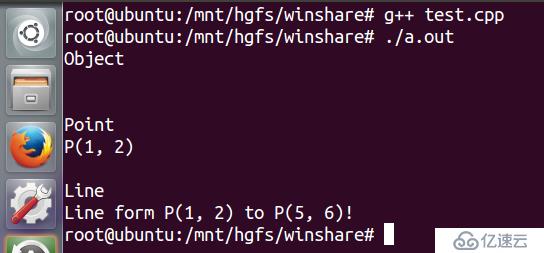您好,登录后才能下订单哦!
我们在上篇博客中介绍了 C++ 中的继承,那么我们想想既然是继承了,子类是否可以直接访问父类中的私有成员呢?根据面向对象理论:子类拥有父类的一切属性和行为,自然子类也就能直接访问父类的私有成员!但是根据 C++ 语法:外界不能直接访问类的 private 成员,因此子类就不能直接访问父类的私有成员!那么到底哪种是正确的呢?我们来编程实验下
#include <iostream>
#include <string>
using namespace std;
class Parent
{
int mv;
public:
Parent()
{
mv = 100;
}
int value()
{
return mv;
}
};
class Child : public Parent
{
public:
int addValue(int v)
{
mv = mv + v;
}
};
int main()
{
return 0;
}我们来编译下看看是否可以通过

编译报错了,说明我们的第二种分析是正确的。那么不是说继承可以获得父类的全部资源嘛,它的私有成员在子类中就不能被访问。接下来我们就要介绍一个概念了,在面向对象中的访问级别不只是 public 和 private,还有个 protected 访问级别。那么 protected 关键字的意义是什么呢?被它修饰的成员不能被外界直接访问,但是它修饰的成员可以被子类直接访问。接下来我们体验下 protected 。
#include <iostream>
#include <string>
using namespace std;
class Parent
{
protected:
int mv;
public:
Parent()
{
mv = 100;
}
int value()
{
return mv;
}
};
class Child : public Parent
{
public:
int addValue(int v)
{
mv = mv + v;
}
};
int main()
{
Parent p;
cout << "p.mv = " << p.value() << endl;
Child c;
cout << "c.mv = " << c.value() << endl;
c.addValue(50);
cout << "c.mv = " << c.value() << endl;
return 0;
}我们来试下将 private 属性换成 protected,看看编译可以通过吗?

我们看到编译通过了,也正常运行了。那么我们在 main 函数中直接给 p.mv 和 c.mv 赋值为 1000 呢?我们看看编译结果

我们看到编译失败了,因为成员变量 mv 是 protected 的,所以在外界不能直接访问。那么为什么在面向对象中需要 protected 呢?我们来想想现实生活中,比如小明要去医院看病。有些隐秘的病史,小明肯定不想让别人知道,但是这时必须得给医生坦白,不然没法治病哈。这时便有了 protected 这个需求了,这个病史不是纯私有的,但又不是暴露在大众之下的。我们面向对象的思想中,为了更完美的贴合生活,便有了 protected 这个关键字。那么我们在定义类时访问级别是怎样选择的呢?我们来看看下面这张表。注:表是由唐长老总结出来的!

关系已经很明确了,我就不多废话了。下来我们来看个示例,关系如下

用程序描述出来就是下面这
#include <iostream>
#include <string>
#include <sstream>
using namespace std;
class Object
{
protected:
string mName;
string mInfo;
public:
Object()
{
mName = "Object";
mInfo = "";
}
string name()
{
return mName;
}
string info()
{
return mInfo;
}
};
class Point : public Object
{
private:
int mX;
int mY;
public:
Point(int x = 0, int y = 0)
{
ostringstream s;
mX = x;
mY = y;
mName = "Point";
s << "P(" << mX << ", " << mY << ")";
mInfo = s.str();
}
int x()
{
return mX;
}
int y()
{
return mY;
}
};
class Line : public Object
{
private:
Point mP1;
Point mP2;
public:
Line(Point p1, Point p2)
{
ostringstream s;
mP1 = p1;
mP2 = p2;
mName = "Line";
s << "Line form " << mP1.info() << " to " << mP2.info() << "!";
mInfo = s.str();
}
Point begin()
{
return mP1;
}
Point end()
{
return mP2;
}
};
int main()
{
Object o;
Point p(1, 2);
Point pn(5, 6);
Line l(p, pn);
cout << o.name() << endl;
cout << o.info() << endl;
cout << endl;
cout << p.name() << endl;
cout << p.info() << endl;
cout << endl;
cout << l.name() << endl;
cout << l.info() << endl;
return 0;
}我们看看编译结果

我们看到在 Object 类中没有相应的描述,所以它的信息为空,别的打印是正确的。通过对继承中的访问级别的学习,总结如下:1、面向对象中的访问级别不只是 public 和 private;2、protected 修饰的成员不能被外界访问,它使得子类能够访问父类的成员;3、protected 关键字是为了继承而专门设计的;4、没有 protected 就无法完成真正意义上的代码复用。
欢迎大家一起来学习 C++ 语言,可以加我QQ:243343083。
免责声明:本站发布的内容(图片、视频和文字)以原创、转载和分享为主,文章观点不代表本网站立场,如果涉及侵权请联系站长邮箱:is@yisu.com进行举报,并提供相关证据,一经查实,将立刻删除涉嫌侵权内容。